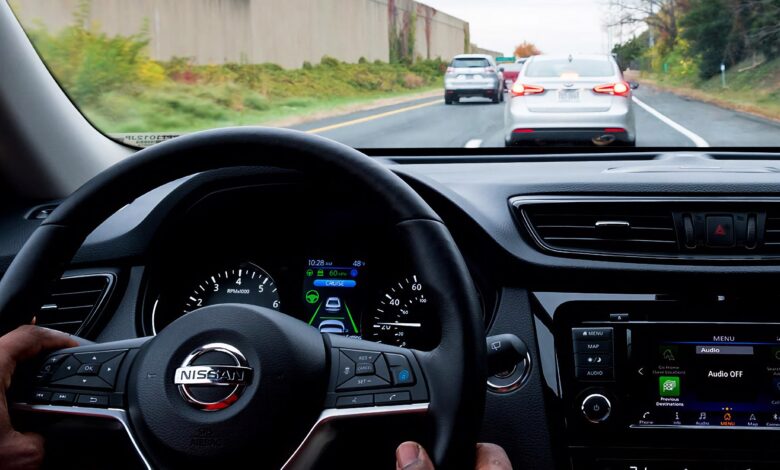US IIHS Research Finds Partial Automation Does Little To Prevents Crashes

[ad_1]
US crash records and insurance data offer little evidence that partial automation systems are prevent collisions, research from the Insurance Institute for Highway Safety (IIHS) and the Highway Loss Data Institute (HLDI) shows.
Studies of BMW and Nissan vehicles showed that liability claims for damage to other vehicles were eight per cent lower for 2017 to 2019 Nissan Rogue SUVs equipped with forward collision warning and automatic emergency braking (AEB) than unequipped vehicles. However, there was no additional benefit associated with adaptive cruise control (ACC) or Nissan’s ProPILOT Assist partial automation system, which adds lane centring on top of ACC. Changes in collision claim rates for the insured’s own vehicle were small for all technologies.
Forward collision warning and AEB were associated with a seven per cent reduction in collision claim rates and a 13 per cent reduction in liability claim rates for 2013 to 2017 BMW and Mini vehicles. Cars that were also equipped with ACC showed a 25 per cent reduction in liability claims and no greater change in collision claims. There were no additional statistically significant reductions associated with BMW’s Driving Assistant Plus partial automation system.
The HLDI’s claims data doesn’t show whether the partial automation system was switched on during a crash, nor do they include the type of road where the insurance claims occurred. This means any potential benefits from partial automation, which is generally designed to be used on high-speed roads, would be diluted by the large volume of insurance claims for low-speed crashes.
Jessica Cicchino, Senior Vice President for Research at the IIHS, tried to determine if safety benefits might be hiding in the HLDI data, so she compared police-reported crash rates for the same BMW and Nissan vehicles that HLDI studied during 2013 to 2022. Although she also had no way of knowing whether the features were switched on at the time of the crash, she was able to restrict her study to the front-to-rear and lane departure crashes that partial automation could potentially prevent. Cicchino looked at crashes on limited-access interstate highways, freeways and expressways, and then looked separately at crashes on other roads.
Like the HLDI, she found substantial reductions in crash rates associated with crash avoidance features.
Front-to-rear crash rates were 49 per cent lower for Rogues with forward collision warning and AEB, and 54 per cent lower for Rogues with forward collision warning, AEB and ACC than for vehicles with no crash avoidance features. There was no significant effect on lane departure crash rates from lane departure prevention.
Unlike the HLDI, Cicchino found larger reductions associated with partial automation. Front-to-rear crash rates were 62 per cent lower for Rogues with ProPILOT Assist than for vehicles without any crash avoidance systems. Lane departure crash rates were 44 per cent lower for Rogues with ProPILOT Assist and lane departure prevention than for unequipped vehicles.
However, looking into those numbers more deeply, Cicchino found that the apparent benefits from ProPILOT Assist were the same on high-speed roads where IIHS research shows partial automation is most likely to be switched on, and low-speed roads where the added convenience it provides is minimal at best. Below 60 km/h, ProPILOT Assist’s lane-centring feature only works if the driver is following another vehicle, suggesting that other characteristics of the equipped vehicles or their drivers were responsible for the reduction.
One such characteristic may be the vehicles’ headlights. Noting that Rogues of that vintage were equipped with poor-rated headlights unless the buyer opted for a premium package, Cicchino discovered that the rate differences were greatest in the dark.
From Nissan marketing materials, she ascertained that the 2018 and 2019 Rogues with ProPILOT Assist were more likely than unequipped vehicles to have acceptable-rated headlights. These headlights reduce single-vehicle night time crashes by about 15 per cent, compared with poor-rated ones, other IIHS research shows.
For the BMW vehicles, Cicchino examined only lane departure crashes because the vehicles with partial automation came with a more advanced front crash prevention system than those without partial automation, making it impossible to isolate the effect of the partial automation system on front-to-rear crashes. She found that neither lane departure prevention alone nor the same feature combined with partial automation had a significant effect on crash rates, either on limited-access highways or on roads with lower speed limits.
Newer partial automation systems may be more effective, but the IIHS said the many years of data that have accumulated for these vehicles make the findings more compelling.
“With no clear evidence that partial automation is preventing crashes, users and regulators alike should not confuse it for a safety feature,” said Cicchino. “At a minimum, safeguards like those IIHS promotes through its rating programme are essential to reduce the risks that drivers will zone out or engage in other distracting activities while partial automation is switched on.”






